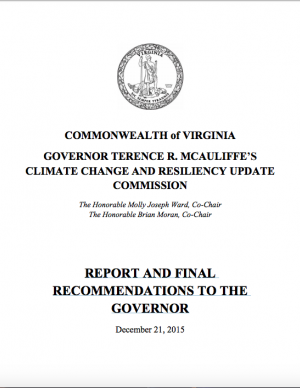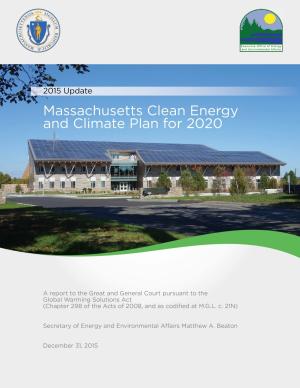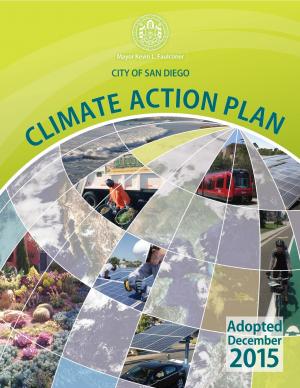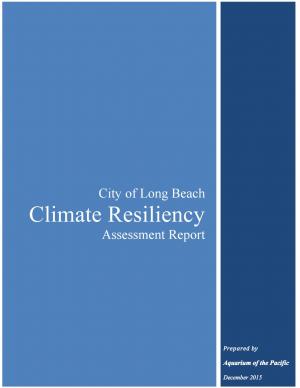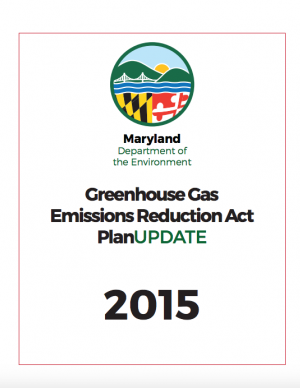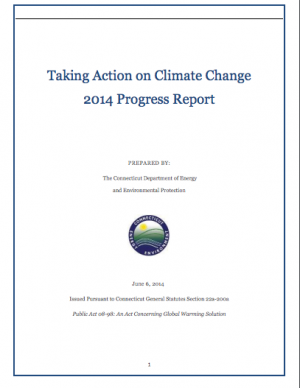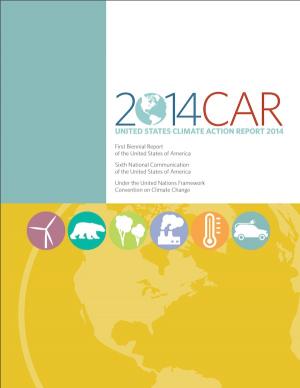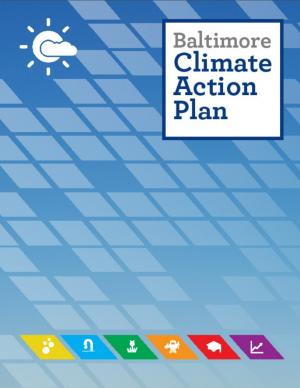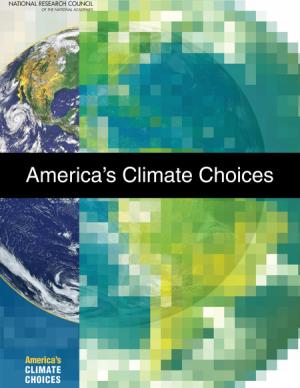Access a range of climate-related reports issued by government agencies and scientific organizations. Browse the reports listed below, or filter by scope, content, or focus in the boxes above. To expand your results, click the Clear Filters link.
On Earth Day 2015, Connecticut Governor Malloy issued Executive Order 46 creating the Governor’s Council on Climate Change, also known as the GC3. The Council is to examine the effectiveness of existing policies and regulations designed to reduce greenhouse gas emissions and identify new strategies to meet the state’s greenhouse gas emissions reduction target of 80 percent below 2001 levels by 2050. It will do so, in part, by developing interim state-wide greenhouse gas reduction targets for years between 2020 and 2050 and by identifying short- and long-term statewide strategies to achieve the necessary reductions.
This report documents recommendations made by the Virginia Climate Commission and describes how they were acted upon. Highlights include appointment of a Chief Resilience Officer and development of a protocol for sea level rise projections. The report also makes 113 recommendations to help Virginia adapt to the consequences of climate change, and to reduce Virginia’s contributions to the problem.
The Global Warming Solutions Act of 2008 required the Massachusetts Secretary of Energy and Environmental Affairs to set a limit on greenhouse gas emissions that would lead to a 10–20 percent reduction in emissions by 2020, and an 80 percent reduction by 2050. This update to Massachusetts' 2010 Climate Action Plan includes recommendations on how to achieve this goal.
With the goal of creating a cleaner San Diego for future generations, the City of San Diego’s Climate Action Plan calls for eliminating half of all greenhouse gas emissions in the City and aims for all electricity used in the city to be from renewable sources by 2035. The Climate Action Plan is a package of policies that will benefit San Diego’s environment and economy. It will help create new jobs in the renewable energy industry, improve public health and air quality, conserve water, more efficiently use existing resources, increase clean energy production, improve quality of life, and save taxpayer money. The plan identifies steps the City of San Diego can take to achieve the 2035 targets, including creating a renewable energy program, implementing a zero waste plan, and changing policy to have a majority of the City’s fleet be electric vehicles. The Climate Action Plan helps achieve the greenhouse gas reduction targets set forth by the State of California. The City’s first Climate Action Plan was approved in 2005 and a commitment to update the plan was included in the City’s 2008 General Plan update.
In January 2015, Long Beach Mayor Robert Garcia asked the Aquarium of the Pacific to take a lead in assessing the primary threats that climate change poses to Long Beach, to identify the most vulnerable neighborhoods and segments of the population, and to identify and provide a preliminary assessment of options to reduce those vulnerabilities. Over the course of 2015, the Aquarium hosted and participated in meetings and workshops with academic and government scientists, business and government leaders, local stakeholders, and Long Beach residents to discuss key issues facing our community as the result of climate change. This report, completed in December 2015, represents the culmination of these efforts. The report offers detailed assessments of the five main threats of climate change to Long Beach: drought, extreme heat, sea level rise and coastal flooding, deteriorating air quality, and public health and social vulnerability. It also provides an overview of what is currently being done to mitigate and adapt to these threats, and other options to consider. Finally, this report presents a series of steps and actions that city leaders and community stakeholders can use as a template for making Long Beach a model of a climate resilient city.
King County, Washington's Strategic Climate Action Plan sets forth strategies for reducing greenhouse gas emissions and preparing for climate change impacts.
This report updates the information contained within Maryland's 2012 Greenhouse Gas Reduction Act (GGRA) Plan. This document summarizes the state’s progress toward achieving the 2020 emissions reduction goal established by the GGRA and shows that Maryland is on target to not only meet, but to exceed, its emission reduction goal.
The purpose of this document is to promote state policy recommendations and actions that aim to help improve Colorado’s ability to adapt to future climate change impacts and increase Colorado’s state agencies' levels of preparedness, while simultaneously identifying opportunities to mitigate greenhouse gas emissions at the agency level.
This report discusses impacts of Hurricane/Post Tropical Cyclone Sandy on fishing and fishing-related businesses in New York and New Jersey one year after landfall. It describes major factors leading to different levels of impact on different sectors, and some reasons behind these different impact levels. Further examined are types of impediments to recovery, aids to recovery, and community impacts. It concludes with (1) two factors that can potentially improve response to, and lessen impacts of, future natural disasters, and (2) lessons learned by the researchers.
In 1993, Portland was the first U.S. city to create a local action plan for cutting carbon. Portland’s Climate Action Plan is a strategy to put Portland and Multnomah County on a path to achieve a 40 percent reduction in carbon emissions by 2030 and an 80 percent reduction by 2050 (compared to 1990 levels). The 2015 Climate Action Plan builds on the accomplishments to date with ambitious new policies, fresh research on consumption choices, and engagement with community leaders serving low-income households and communities of color to advance equity through the City and County’s climate action efforts.
Successfully negotiating climate change challenges will require integrating a sound scientific basis for climate preparedness into local planning, resource management, infrastructure, and public health, as well as introducing new strategies to reduce greenhouse gas emissions or increase carbon sequestration into nearly every sector of California’s economy. This Research Plan presents a strategy for developing the requisite knowledge through a targeted body of policy-relevant, California-specific research over three to five years (from early 2014), and determines California’s most critical climate-related research gaps.
In September of 2013, Governor Jack Markell of Delaware signed Executive Order 41 directing state agencies to address the causes and consequences of climate change. The order asked for recommendations to reduce greenhouse gas emissions, increase resilience to climate impacts, and find ways to avoid or minimize flood risks caused by rising sea level. The order also created a committee to oversee the development and implementation of recommendations.
This Synthesis Report summarizes the Fifth Assessment Report (AR5) of the Intergovernmental Panel on Climate Change (IPCC). This report distills, synthesizes, and integrates the key findings of the three IPCC Working Group contributions—The Physical Science Basis; Impacts, Adaptation, and Vulnerability; and Mitigation of Climate Change—to the AR5 for the benefit of decision makers in government, the private sector, and the general public. The report also includes findings from two Special Reports released in 2011: Renewable Energy Sources and Climate Change Mitigation and Managing the Risks of Extreme Events and Disasters to Advance Climate Change Adaptation. The Synthesis Report confirms that climate change caused by human activities is having impacts on ecosystems and human well-being across the U.S. and around the world.
This report documents how rapid innovation and new investment in infrastructure are making it possible to tackle climate change and improve economic performance. Countries at all income levels have the opportunity to build lasting economic growth at the same time as they reduce the immense risk of climate change.
Virginia's Governor McAuliffe signed Executive Order 16 establishing the Virginia Energy Council in 2014; the council was formed to provide advice on the development and implementation of the 2014 Virginia Energy Plan. This plan was developed to provide a comprehensive view of where Virginia has been and currently is in terms of its energy assets, and it charts a path forward for energy policy in the commonwealth.
The report highlights the state’s achievement of returning to 1990 emissions levels by 2010. Additionally, Connecticut is likely to meet its goal of acheiving emissions levels 10 percent below 1990 levels before 2020. The report also presents the state’s climate adaptation and resiliency work.
The National Climate Assessment assesses the science of climate change and its impacts across the United States, now and throughout this century. It documents climate change-related impacts and responses for various sectors and regions, with the goal of better informing public and private decision making at all levels.
The assessment draws from a large body of scientific peer-reviewed research, technical input reports, and other publicly available sources; all sources meet the standards of the Information Quality Act. The report was extensively reviewed by the public and experts, including a panel of the National Academy of Sciences, the 13 federal agencies of the U.S. Global Change Research Program, and the Federal Committee on Environment, Natural Resources, and Sustainability.
On September 27, 2006, then-Governor Arnold Schwarzenegger signed California's Global Warming Solutions Act of 2006, which required the reduction of greenhouse gas emissions to 1990 levels by 2020. The California Air Resources Board is the lead agency for implementing the bill. One of the board's tasks was to create a scoping plan that would outline California’s strategy to achieve the 2020 greenhouse gas emission goal. This current scoping plan is an update from the original version, published in 2008. In addition to updates, this plan also contains progress reports on how California is progressing towards its goals.
This Fifth Assessment Report issued by the Intergovernmental Panel on Climate Change (IPCC) Working Group III is a comprehensive assessment by of all relevant options for mitigating climate change through limiting or preventing greenhouse gas emissions, as well as activities that remove them from the atmosphere.
These guidelines—which include climate change and sea level rise considerations—were developed to provide a comprehensive framework for site assessment and alternatives analysis to determine the need for shore protection and identify the technique that best suits the conditions at a given site. There are many guidelines and manuals for the design of "protection" techniques for the more typical open coast, but prior to the Marine Shoreline Design Guidelines (MSDG) there was almost no guidance that reflected the variety of conditions found in Puget Sound. For this reason, the MSDG were created to inform responsible management of Puget Sound shores for the benefit of landowners and shared natural resources.
The U.S. Department of State prepared the first Biennial Report of the United States of America to the United Nations Framework Convention on Climate Change (UNFCCC). The report details actions the United States is taking domestically and internationally to mitigate, adapt to, and assist others in addressing climate change.
The Pennsylvania Climate Change Act requires the state's Department of Environmental Protection to submit an updated climate change action plan to the governor every three years. This report is the first update to the original plan issued in December 2009.
This report, the first of its kind for the City of Grand Rapids, outlines the condition of the city's climate resiliency and offers recommendations for how it can both impact and adapt to climate change. The report's goal is to both spur a larger community conversation around processes that will enable Grand Rapids to become a more climate-resilient city and to spur many specific short- and near-term projects, policies, programs, and plans to mitigate the effects of climate change. The report documents projected local climate changes, their potential negative impact to low-income families, and outlines small near-term solutions that the city can make to curb or adapt to climate change. Recommendations include investing in green space and improving the city's tree canopy, improving the city's energy autonomy, and implementing green street infrastructure materials and maintenance techniques.
The Dane County Climate Change Action Council was formed in March 2013 with a mission to ensure that Dane County government was better prepared for weather extremes brought on by global climate change. The Council facilitated an internal review of county preparations and potential modifications to the operations and capital investments of the county, resulting in this report identifying Dane County’s potential vulnerabilities to weather extremes associated with global climate change and strategies to adapt to a changing climate. The report is the first step in the county’s effort to improve the resiliency of its climate-sensitive resources in the face of climate change; future steps will include cross-departmental collaborations to implement the adaptation strategies outlined in the report.
The Sacramento-San Joaquin River Delta is the grand confluence of California’s waters, the place where the state’s largest rivers merge in a web of channels—and in a maze of controversy. In 2009, seeking an end to decades of conflict over water, the California Legislature established the Delta Stewardship Council with a mandate to resolve long-standing issues. The first step toward that resolution is the Delta Plan—a comprehensive management plan for California’s Sacramento-San Joaquin Delta, developed to guide state and local agencies to help achieve the co-equal goals of providing a more reliable water supply for California and protecting, restoring, and enhancing the delta's ecosystem.
President Obama's Climate Action Plan includes a series of executive actions to reduce carbon pollution, prepare the United States for the impacts of climate change, and lead international efforts to address global climate change.
This report provides a comprehensive overview of activities undertaken by the California Department of Transportation (Caltrans) to reduce greenhouse gas (GHG) emissions and adapt the state’s transportation system to the impacts of climate change. It also identifies opportunities for additional reductions in GHG emissions and climate adaptation activities that Caltrans may consider in the future.
This Climate Action Plan represents Baltimore's commitment to being a leader in sustainability and improving their city environment. The plan contains feasible measures to help the city reduce greenhouse gas emissions and curb the effects of climate change. The plan calls for a goal of a 15 percent reduction in greenhouse gas emissions by 2020. In order to reach this goal, the plan promotes renewable energy generation and energy retrofits, waste diversion, and water efficiency. CAP measures will help citizens save energy and money, as well as encourage the use of sustainable modes of transit, high-density urban land use, and increased tree plantings. From the mayor's message: "While we as a City alone cannot change the course of world climate patterns, we must do our part. The City of Baltimore’s Climate Action plan is our promise to take action, reduce our greenhouse gas emissions, increase our quality of life, and grow Baltimore. "
Preparation of the Strategic Climate Action Plan is an opportunity to take stock of progress related to climate change, to look forward, and to plan for the future.
This summary report provides historical and projected estimates of emissions of non-carbon dioxide greenhouse gases (GHGs) from anthropogenic sources. The report provides a consistent and comprehensive estimate of non-CO2 greenhouse gases for 92 individual countries and eight regions. The analysis provides information that can be used to understand national contributions of GHG emissions, historical progress on reductions, and mitigation opportunities. The projections represent a business-as-usual scenario that includes reductions from established sector-specific programs but not economy-wide programs or commitments.
The report introduces key health connections to climate change mitigation strategies, suggestions of where these fit into a Climate Action Plan, a process for forging partnerships between planning and health organizations, links to data that will help planners identify and reference the existing health status of their jurisdiction, and supporting resources.
In November 2008, Governor Beshear of Kentucky issued a report that included a strategy to lessen carbon dioxide emissions and to reduce Kentucky’s carbon footprint. In 2010 the Kentucky Climate Action Plan Council (KCAPC) was established to assist in developing the Kentucky Climate Action Plan. The KCAPC was charged with producing a greenhouse gas emissions inventory and forecast, compiling a Climate Action Plan with recommended greenhouse gas reduction goals, and potential actions to assuage climate change and improve energy efficiency in various sectors. This document is the KCAPC's final report.
The San Francisco Bay Plan, originally adopted by the California Legislature in 1969, contains the policies that the San Francisco Bay Conservation and Development Commission (BCDC) uses to determine whether permit applications can be approved for projects within the Commission’s jurisdiction—consisting of the San Francisco Bay, salt ponds, managed wetlands, certain waterways, and land within 100 feet of the Bay. On October 6, 2011, the BCDC unanimously approved an amendment to the Plan to update the 22-year-old sea level rise findings and policies and more broadly address climate change adaptation.
In 2008, agricultural greenhouse gas sources accounted for about six percent of total U.S. greenhouse gas emissions. This report, known as the USDA GHG Inventory, was developed to provide a comprehensive assessment of the contribution of U.S. agriculture and forestry to greenhouse gas emissions and carbon sequestration, providing an in-depth look at greenhouse gas emissions and carbon sequestration at the state and regional scales.
This report, the final in a series from the National Academies, makes the case that the environmental, economic, and humanitarian risks posed by climate change indicate a pressing need for substantial action to limit the magnitude of climate change and to prepare for adapting to its impacts. The report advocates for an iterative risk management approach to climate change and using strong federal climate policies to support and enhance existing local, state, and private-sector efforts.
This special report assesses the scientific literature on the potential role of renewable energy in the mitigation of climate change for policymakers, the private sector, academic researchers, and civil society. It covers six renewable energy sources—bioenergy, direct solar energy, geothermal energy, hydropower, ocean energy and wind energy—as well as their integration into present and future energy systems. It considers the environmental and social consequences associated with the deployment of these technologies, and presents strategies to overcome technical as well as non-technical obstacles to their application and diffusion.


